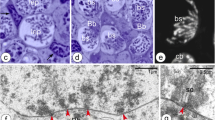Summary
-
1.
A structure which is tentatively called a “nuclear body” has been observed in microsporocytes in a large number of species of Bromus. It was found in diploid and polyploid species and in species with complements of large (L-)chromosomes, medium (M-)chromosomes or L- and M-chromosomes. These species were collected in North and South America and Europe. It is suggested that the nuclear body occurs regularly in species of the genus Bromus.
-
2.
The nuclear body was first visible at pachytene. It was generally single. In some individuals it disappeared at the end of prophase; in others it was present during later stages of meiosis, in some instances as late as the quartet. The nuclear body was not observed when the quartet cells had separated. Before it disappeared the nuclear body underwent a sudden or gradual diminution. It decreased in size, or became faint-staining and faded away; or it decreased in size and faded. The nuclear body generally disappeared at the end of prophase in the diploid and tetraploid species and was present at metaphase-I and later stages in higher polyploid species.
-
3.
When the nuclear body was present in later stages of meiosis it behaved as follows: It was extruded from the spindle at metaphase-I and frequently came to lie in the polar region of the cell; it was not included in either nucleus at telophase-I. A single nuclear body was present in one dyad cell; it lay outside the spindle at metaphase-II, and was included in one of the cells of the quartet.
-
4.
A very great range in the size of the nuclear body was found in early stages of meiosis. Some variation in size was found within individuals and among individuals of the same species. Present data indicate some relationship between chromosome number and size of the nuclear body. The largest nuclear bodies were found in duodecaploid and octoploid and the smallest in diploid species; however an exact correspondence was not observed.
-
5.
The nuclear body is extremely variable in shape. It has a vesicular appearance; there is great variation in the number, size and staining of the vesicles. The appearance of the nuclear body may vary within and among anthers and individuals.
-
6.
The nuclear body is not associated with the nucleolus at pachytene, nor with the nucleolar organizing regions of specific bivalents. The nuclear body is often touching a bivalent or attached by fine strands to a bivalent during prophase. However, there appears to be no specifically differentiated region of any bivalent with which it is generally associated. The nuclear body may be associated with terminal or interstitial regions of bivalents which differ in size or chromomere pattern. It was more frequently associated with bivalents in some individuals than others.
-
7.
The nuclear body was not found in mitotic divisions in shoot or root tips and thus appears to be related specifically to the meiotic divisions. It may arise as an exudate from some chromosomes, or it may be extruded from the nucleolar material; it seems less likely to arise from the karyolymph. It may be composed of some materials discarded in preparation for meiosis or during its earliest stages, which are perhaps related to concurrent changes in chromosome organization.
-
8.
Observations are considered which suggest that a structure similar to the nuclear body observed in Bromus may be present in other plant genera.
Similar content being viewed by others
References
Dillewijn, C. Van: Zytologische Studien in der Gattung Populus L. Genetica 22, 131–182 (1940).
Fabergé, A. C.: Snail stomach cytase, a new reagent for plant cytology. Stain Technol. 20, 1–4 (1945).
Raven, P. H.: The introduced species of Bromus, sect. Ceratochloa, in California. Leafl. West. Bot. 8, 151–154 (1957).
Resende, F.: Die Nukleolen bei Antirrhinum majus L. Dtsch. bot. Ges. 58, 460–470 (1940).
Rosenberg, O.: Die semiheterotypische Teilung und ihre Bedeutung für die Entstehung verdoppelter Chromosomenzahlen. Hereditas (Lund) 8, 305–338 (1927).
Sarvella, P.: Circular structures associated with pachytene chromosomes. Canad. J. Genet. Cytol. 3, 89–90 (1961).
Schulz-Schaeffer, J.: Cytologische Untersuchungen in der Gattung Bromus L. Z. Pflanzenzüchtung 35, 297–320 (1956).
—, and D. Markarian: Cytologische Untersuchungen in der Gattung Bromus L. II. Untersuchungen an Wurzelspitzen zur Klärung der Chromosomenmorphologie bei den Untergattungen Ceratochloa und Bromus. Z. Pflanzenzüchtung 37, 299–316 (1957).
Stebbins Jr., G. L.: The origin of the complex of Bromus carinatus and its phytogeographic implications. Contr. Gray Herb. 165, 42–55 (1947); - The evolutionary significance of natural and artificial polyploids in the family Gramineae. Proc. 8th Int. Cong. Genetics 1949, pp. 461–485.
—, and H. A. Tobgy: The cytogenetics of hybrids in Bromus. I. Hybrids within the section Ceratochloa. Amer. J. Bot. 31, 1–11 (1944).
— and J. R. Harlan: The cytogenetics of hybrids in Bromus. II. Bromus carinatus and Bromus arizonicus. Proc. Calif. Acad. Sci. 25, 307–322 (1944).
Stebbins, G. L., and Marta S. Walters: The evolutionary significance of two synthetic allopolyploid species of Bromus. Port. Acta biol., Ser. A — R. B. Goldschmidt Vol., 106–134 (1949).
Tischler, G.: Allgemeine Pflanzenkaryologie. 2. Hälfte: Kernteilung und Kernverschmelzung. 2. Liefg, 2. Aufl., S. 1–1038. Berlin-Nikolassee: Naturwiss. Verlag vorm. Gebr. Borntraeger 1951.
Walters, Marta S.: Aberrant chromosome movement and spindle formation in meiosis of Bromus hybrids: An interpretation of spindle organization. Amer. J. Bot. 45, 271–289 (1958); - Rates of meiosis, spindle irregularities and microsporocyte division in Bromus trinii × B. carinatus. Chromosoma (Berl.) 11, 167–204 (1960); - A nuclear body in meiosis of Bromus. Rec. Genet. Soc. Amer. 31, 123 (1962).
Author information
Authors and Affiliations
Rights and permissions
About this article
Cite this article
Walters, M.S. A nuclear body in meiosis of Bromus. Chromosoma 14, 423–450 (1963). https://doi.org/10.1007/BF00326787
Received:
Issue Date:
DOI: https://doi.org/10.1007/BF00326787




